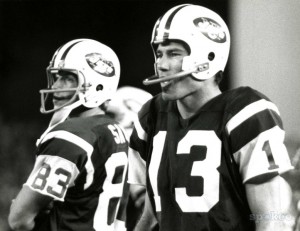by Chase Stuart
on June 27, 2022
Ten years ago, I looked at the passing distribution of NFL teams since 1970. Let’s revisit that post today, with an expanded look at what’s happened over the last decade.
I examined every season in the NFL since 1970, when the AFL and NFL merged. I then calculated the percentage of receiving yards for each team that went to its running backs, tight ends and wide receivers. The graph below shows the breakdown from each season from 1970 through 2021. . There are two large trends: wide receivers have become slightly more important over time, jumping from 53% of the receiving pie during the ’70s to 63% over the last ten years. The entire jump, though, came in the aftermath of the 1978 rules changes, as the percentage of receiving yards that went to wide receivers steadily rose form 53% in 1977 to 62% in 1987 and 1988.
The other notable change is the switch in primacy of the tight end relative to the running back. From 1970 to 1983, running backs gained 27% of all receiving yards while tight ends picked up just 19% of the pie. That breakdown was pretty consistent each season: tight ends were at 18%, 19%, or 20% almost every season, and running backs consistently gained between 25% and 29& of the receiving game. The 1984 season was a weird outlier: running back production was way down while tight end production was up, but that was mostly a one year blip. From 1985 to 1994, running backs averaged 22% of the pie, a noticeable decrease from the pre-1984 era, but tight ends dropped, too, down to 15% during that decade. And from 1986 through 2007, tight ends were under 20% of the receiving pie each year. But tight ends have held steady at 20 or 21 percent, while running back production in the receiving game has dropped to about 16%. In 2004, tight ends gained more receiving yards as a group than running backs, and it has remained that way in every season since. This is strongly tied, of course, to the near-elimination of the fullback position from the modern game. [continue reading…]
Tagged as:
1978 Rules Changes
{ }
by Chase Stuart
on May 16, 2018
All football historians know about the 1978 rules changes. Here’s an except I wrote about how those changes changed the NFL forever:
There were two key rules changes enacted in 1978. The first prohibited bumping, chucking, or otherwise making anything other than incidental contact with a receiver beyond five yards from the line of scrimmage. The second allowed offensive lineman to be able to extend their arms, and push with open hands, allowing for better blocking and fewer holding penalties. With those rules in place, quarterbacks needed fewer blockers and receivers needed to be less skilled to get open. As a result, three and four wide receiver sets become more common, and the fullback was phased out…. From 1970 to 1977, non-starting wide receivers consistently produced just under 10% of the team’s total receiving yards; by 1990, that number had doubled, and has shown no signs of subsiding.
So what was the impetus for those changes? The 1977 season, which was a passing nightmare. In 1976, teams averaged 4.07 Adjusted Net Yards per Attempt, defined as (Gross Passing Yards + 20 * TDs – 45 * INTs) divided by (Pass Attempts – Sack Yards Lost). Now a 4.07 league average ANY/A wasn’t high – the ’60s NFL saw an average ANY/A of 4.59 — but it wasn’t notably low, either. In fact, 1976 was a slightly better passing environment than the trailing five year average of 4.01. Then, 1977 happened: teams averaged just 3.55 ANY/A, the lowest mark in the NFL since 1953. This was a dramatic decline in passing production of 0.52 Adjusted Net Yards per Attempt.
Fast forward 40 years. In 2016, the league-wide ANY/A average was 6.22, a shade off of the 6.26 ANY/A average in 2015. In fact, 2014 (6.14 ANY/A), 2015 (6.26), and 2016 (6.22) are the three best passing seasons in NFL history. There was little reason to expect 2017 to be any different, but it was: the NFL average ANY/A dropped to 5.91 last season, a decline of 0.31 ANY/A. That was the single largest year-over-year decline since 1976-1977. [continue reading…]
Tagged as:
1978 Rules Changes
{ }
by Chase Stuart
on August 28, 2015
Seven and a half years ago, I asked the question, why do teams run the ball? Today, I want to revisit that post, given that a lot has happened over the last seven and a half years.
Let’s begin my analyzing league-wide pass and rush efficiency. To measure rush efficiency, we will use Adjusted Yards per Carry, which is calculated as follows:
(Rush Yards + 11 * Rush TDs + 9 * Rush First Downs) / (Rushes)
For passing, we will use a modified version of ANY/A by also giving credit for first downs. Here’s the formula:
(Gross Pass Yards – SackYardsLost + 11 * Pass TDs + 9 * Pass First Downs – 45 * INTs) / (Pass Attempts + Sacks)
[continue reading…]
Tagged as:
1978 Rules Changes
{ }
by Chase Stuart
on August 5, 2012

Maynard and Sauer were the stars of the late '60s Jets, but Maynard first achieved success with another New York wideout.
There have been 105 teams to have at least two players gain 1,000 receiving yards in a season. It first happened in 1960 in the AFL, where wide receivers benefited by playing against lower quality of defensive backs and also a fourteen-game schedule (the NFL schedule switched from a 12 to 14 games the following year). New York’s
Don Maynard led the team with 1,265 yards, while
Art Powell finished with 1,167. Maynard and Powell repeated the feat in 1962, and then Maynard and the Jets’
George Sauer also joined the club in ’67 and ’68. In total, seven different AFL teams fielded a pair of 1,000 yard receivers, with
Bill Groman and
Charley Hennigan (1961, Houston),
Warren Wells and
Fred Biletnikoff (1968, Oakland) and
Lance Alworth and
Gary Garrison (1968, San Diego) rounding out the list.
But in the NFL, no team fielded a pair of 1,000 yard receivers in the ’60s, even with the 14-game schedule. And as professional football entered the dead ball era in the 1970s, it wasn’t until the passing rules changes and the advent of the 16-game schedule that an NFL team — in fact, three NFL teams — first fielded multiple 1,000-yard receivers.
| Trivia hint 1 |
SelectShow |
The three NFL teams to first set this record all did it in 1979.
|
| Trivia hint 2 |
SelectShow |
Of the six wide receivers, only one is in the Hall of Fame.
|
| Trivia hint 3 |
SelectShow |
The teams were San Diego, Dallas and New England.
|
| Click 'Show' for the Answer |
SelectShow |
In 1979, Dallas’ Tony Hill (1,062) and Drew Pearson (1,026) became the first pair of NFC teammates to crack the 1,000-yard mark. That same year, in the AFC, John Jefferson (1,090) and Charlie Joiner (1,008) matched the feat for the Chargers and Stanley Morgan (1,002) and Harold Jackson (1,013) did the same for the Patriots.
|
Tagged as:
1978 Rules Changes,
Weekend Trivia
{ }
by Chase Stuart
on July 17, 2012
One of my law school professors was very quirky, even by law school professor standards. His preferred examination method was multiple choice, but with a twist. After grading each exam, he would then divide the students into quarters based on their test score. He would then re-examine each question, and measure how the top quarter of students performed on each question relative to the bottom quarter. Any question that more bottom-quarter students answered correctly than top-quarter students would be thrown out, and the exam would be re-graded. As he delicately put out, ‘if the wrong students are getting the question right, and the right students are getting the question wrong, it’s a bad question.’
NFL passing records are falling for a variety of reasons these days, including rules changes and league policies that make the passing game more effective. But there’s another reason: for the first time in awhile, the right people are throwing the most passes in the league. And there’s no better example of that than Drew Brees. Since coming to the Saints in 2006, he’s ranked 1st or 2nd in pass attempts four times, and ranked in the top three in net yards per attempt four times. But even since ’06, we’ve seen the passing game evolve, as the best quarterbacks are now the most likely ones to finish near the top of the leaderboard in pass attempts. In 2010, Peyton Manning had his first 600-attempt season… when he threw 679 passes for the Colts. Tom Brady threw 611 passes last year for the 13-3 Patriots, making New England one of just three teams to threw 600 pass attempts and win 13 or more games in a season. The other two teams? The ’09 Colts and the ’11 Saints.
At various points in the history of the NFL, passing was viewed as an alternative to running, and the high-attempt game was the province of the trailing team. But times are changing in the NFL. I calculated each team’s net yards per attempt (NY/A) and total pass attempts (attempts plus sacks) for every year since 1970. Then, I measured the correlation coefficient between NY/A and pass attempts for the league for each of the last 42 seasons. The chart below shows the correlation coefficient between those two variables (NY/A and pass attempts) for the league as a whole for each year since the merger:
[continue reading…]
Tagged as:
1978 Rules Changes,
Drew Brees,
NFC South,
RPO 2012,
Saints,
Simpson’s Paradox
{ }
by Chase Stuart
on June 25, 2012

Jimmy Graham's invisible mirror displays his uniform as aesthetically pleasing
Last year, Jimmy Graham broke Kellen Winslow’s record for receiving yards in a single season by a tight end. Winslow gained 1,290 yards as a second-year player in 1980 for the San Diego Chargers. Last year, Graham finished with 1,310 receiving yards in his second season, while also catching 99 passes and scoring 11 touchdowns. Graham broke Winslow’s 31-year-old record, but Graham was leapfrogged in about fifteen minutes. By the end of the last Sunday of the regular season, Rob Gronkowski had upped his total to 1,327 yards, making him the new single-season leader in receiving yards and receiving touchdowns by a tight end.
Jason Witten and Aaron Hernandez each topped 900 receiving yards in 2011, and Tony Gonzalez, Antonio Gates and Vernon Davis remain among the game’s elite at the position. It would not be difficult to argue that we’re in a golden age of tight ends. There’s no doubt that passing has increased in both quantity and quality; have tight ends been the biggest beneficiaries of that change?
I examined every season in the NFL since 1970, when the AFL and NFL merged. I then calculated the percentage of receiving yards for each team that went to its running backs, tight ends and wide receivers. The table below shows those results.
[continue reading…]
Tagged as:
1978 Rules Changes,
Jimmy Graham,
Rob Gronkowski,
Tight Ends
{ }


